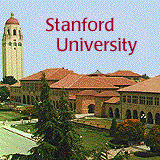Tuesday March 4, 2003
UNIVERSITY PAY
FROZEN
HARD TIMES HERE AGAIN!
STANFORD'S FISCAL CRISIS DEEPENS
By Amy Williams, Staff Writer
 PALO
ALTO -- Last month, Stanford's provost, John Etchemendy, announced
a hiring freeze. The moratorium was to apply to all regular and
academic staff positions, including temporary and casual employees,
as well as staff members hired through employment agencies.
PALO
ALTO -- Last month, Stanford's provost, John Etchemendy, announced
a hiring freeze. The moratorium was to apply to all regular and
academic staff positions, including temporary and casual employees,
as well as staff members hired through employment agencies.
Although the freeze would have spared
faculty positions, and deans. However, it was hoped that the administration
would retain the discretion not to fill empty faculty posts in
their departments. However, those pending budget cuts could include
layoffs, as well.
University officials project a reduction
of 8 percent in the university's general-fund budget in the 2004
fiscal year. At $507-mil in the current fiscal year, the general
fund represents about one-fourth of the university's total budget.
"Even the most prestigious and most financially well endowed
among us still feel the effects of the bear market," said
Randall S. Livingston, Stanford's vice president for business
affairs and chief financial officer.
Making matters worse, this week Stanford
announced on its website that things have gone from bad to worse
in just the last couple of weeks. Now, the university is facing
a $25-million deficit. Nearly 9,000 Stanford workers will have
their wages frozen at last year's rates. All bets are off.
The Bulldog Newspaper has learned that Stanford
president, John L. Hennessy has just made it known that he will
voluntarily take a 5-percent salary cut.
University officials are now projecting
a reduction of 8 percent in the university's general-fund budget
in the 2004 fiscal year. Hold on it could be getting worse.
At $507-million in the current fiscal year, the general
fund of $507-million
is about twenty-five percent of the Stanford's total budget according
to Randall S. Livingston, Stanford's vice president for business
affairs and chief financial officer.
Part
of the present fiscal crisis may be the generous raises averaging
8-10% over the past couple of years, or so. Trustees this week
raised tuition, room and board rates for he academic year '03-'04.
Ther hike is 4.8 percent increase over the current year's rates
for undergraduates.
Undergraduate tuition was set
at $28,563, a 5 percent increase from $27,204 this year. The standard
undergraduate room rate was set at $4,702, compared with $4,450.
Standard board increased to $4,347 from
$4,230. "Given the downturn in the economy, this year is a challenging
one. But we have attempted to limit the increase as much as possible,"
said Isaac Stein, chair of the Board of Trustees. "Despite mounting
economic pressures, we have kept the overall rate of increase
slightly below last year's increase."
Stein also noted, "Our financial aid
program is one of the best in the country and our commitment to
need-blind admission remains unchanged. Because of the state of
the economy, we have seen a rise in the number of families who
need aid, and we will continue to provide necessary funds for
those who have demonstrated need."
Stanford is one of the few private universities
with a need-blind admissions policy, accepting students regardless
of their ability to pay. Tuition covers only 60 percent of the
costs of educating an undergraduate.
Tuition for terminal graduate students
-- doctoral candidates who have completed all coursework and degree
requirements except the dissertation -- was increased to $4,950
for three quarters. At this figure, which is an increase of 50
percent over the previous rate, Stanford's terminal graduate rate
is still lower than that charged by most of its peer institutions.
Many of these institutions charge full
tuition until the doctoral degree is awarded. In addition, part-time
graduate tuition will increase from 62 percent of full tuition
to 65 percent of full tuition.
The new part-time tuition rate was set
at $18,600. Full-time tuition rates for graduate students vary
depending on the school. Rates for most schools will increase
by 5 percent. Tuition at the Graduate School of Business next
year will rise 8.9 percent to $36,252.
[Editor's
Note: Go directly to latest Stanford
University News Release page.]
Comment
Copyright
1958-2003 The Bulldog News








